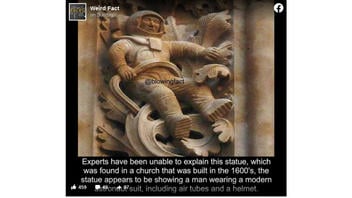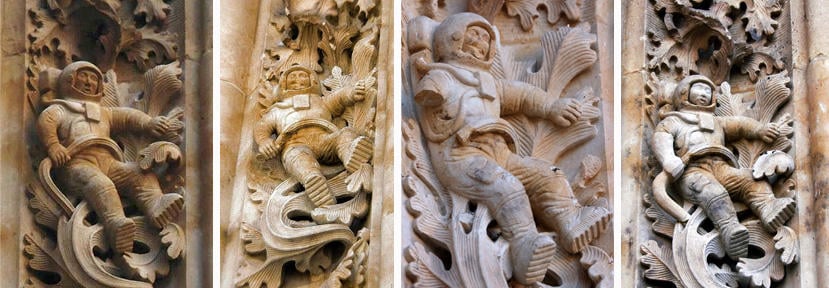
Is there any question about how a figure of a modern astronaut came to be included in the intricate decorative carvings on a Spanish cathedral built in the 1600s? No, it's well documented in the recent past: The astronaut was added to the cathedral in 1992 when some restorations were made. The figure of the astronaut was chosen to represent the 20th century. Several other figures were added at the time of this restoration, including an Iberian lynx, a bull, a stork, a crayfish, a rabbit, and a creature eating ice cream.
The story reappeared as a post (archived here) where it was published by the Facebook page Weird Fact on November 22, 2020. The text caption on the photo read:
Experts have been unable to explain this statue, which was found in a church that was built in the 1600's, the statue appears to be showing a man wearing a modern astronaut suit, including air tubes and helmet.
This is what the post looked like on Facebook at the time of writing:
(Source: Facebook screenshot taken on Tue Nov 24 14:07:34 2020 UTC)
There are two cathedrals in Salamanca, Spain, the old and the new, and they are connected. Construction on the old cathedral began in the 12th century and continued for centuries. The new cathedral is also quite old. Construction on it began in the 16th century and was not finished until the 18th century.
In 1992, some restorations were done. Jerónimo Garcia was the director of ProArt, a restoration company tasked with the project, and he commissioned several stone carvers to work on the project, including Miguel Romero. It is traditional that stone carvers doing repairs on cathedrals leave a "signature" from their time. This is not a personal signature, but a touch from the time period when the change was made. In the spring of 1992, there was some big news in Spain that may have helped the stone workers finalize their plan for the touch of the 20th century: Spaniard Pedro Duque was selected as an astronaut candidate by the European Space Agency. This was a great source of national pride for Spain. The story of the stone carver's decision-making process is explained in this June 2018 La Gaceta de Salamanca article, "Pedro Duque, the minister who 'lives' day and night in the Cathedral of Salamanca."
The astronaut stone carving is located on the north side of the new cathedral at an entry called Puerta de Ramos. Unfortunately, the isolated location has allowed vandals to damage many of the carvings in the decades since the restoration. In this screenshot of a 2017 Google Streetview Image of Puerta de Ramos, the attention of the tourists has been drawn to the astronaut in the intricate carvings flanking the left side of the doors.

Puerta de Ramos of the New Cathedral of Salamanca - Google Streetview Image August 2017
The artist who carved the astronaut, Miguel Romero, was interviewed in this October 2010 article from El Norte de Castilla titled, "La Puerta de los Gamberros" ("The Door of the Hooligans"). He discussed with sadness the damage of the vandals. (automatically translated from Spanish):
It is a work that is highly exposed, in a place that remains empty at night, and which is also at a very accessible height for anyone ... It seems that these years there have been many people who have wanted to leave their mark on that cover, of course they have not exactly left stonemason marks."
Th article continues:
The Salamanca artist jealously guards in his studio the photographs taken in the days after completing the restoration work on the Portada de Ramos. Although apparently those images and those that can be taken now are similar, the detail reveals that the stone has been filled with wounds.
The first image on the left below shows the original carving. The center photos show how the little figure was progressively damaged -- his face, the delicate nose, and the acanthus leaf at the knee, and then the whole right arm was broken off. In the final picture the damage has been patched and he has a newly carved face.
















